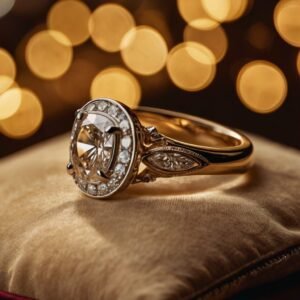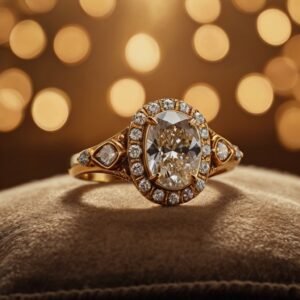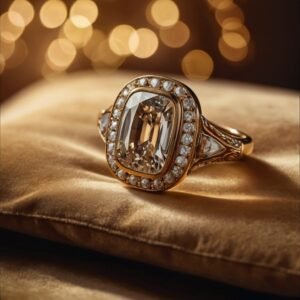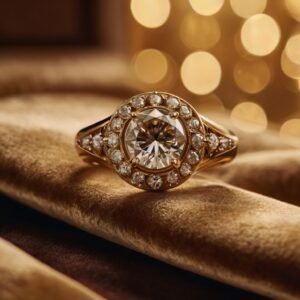
Introduction
Engagement rings symbolize love, commitment, and the promise of a future together. For many, these exquisite pieces of jewelry hold immense sentimental and financial value. As we step into 2025, the importance of protecting these cherished items through jewelry insurance becomes increasingly evident. Whether it’s due to loss, theft, or damage, having the right insurance can provide peace of mind for engagement ring owners.
At **zaroraterishta.com**, we understand that investing in an engagement ring is not just about the financial aspect; it’s about the memories, emotions, and milestones it represents. The thought of losing such a significant piece can be overwhelming, making the need for comprehensive jewelry insurance more crucial than ever.
This article will explore jewelry insurance in 2025, focusing on what engagement ring owners should know. We will cover the types of coverage available, how to choose the right policy, the claims process, and real-life stories that highlight the importance of having jewelry insurance. By the end, you will have a clearer understanding of how to protect your investment and ensure that your engagement ring remains a cherished symbol of love for years to come.

1. Understanding Jewelry Insurance
Jewelry insurance is specifically designed to protect valuable jewelry items against loss, theft, and damage. While many people may assume their homeowner’s or renter’s insurance covers jewelry, these policies often have limitations and exclusions. Jewelry insurance provides tailored coverage that ensures your precious items are adequately protected.
Types of Jewelry Insurance Policies
When considering jewelry insurance, it’s essential to understand the different types of policies available. Here are the most common options:
1. **Standalone Jewelry Insurance**: This type of policy is specifically for jewelry items and offers comprehensive coverage for loss, theft, and damage. Standalone policies typically provide higher limits and fewer exclusions compared to homeowners’ insurance. They also cover the full value of the jewelry item, including its appraised value.
2. **Rider or Endorsement on Homeowners Insurance**: Some homeowners’ insurance policies allow you to add a rider or endorsement to cover specific valuable items, including jewelry. While this option may be less expensive, it often comes with lower coverage limits and higher deductibles. Additionally, claims may be subject to the overall limits of the home insurance policy.
3. **Blanket Policy**: A blanket jewelry insurance policy provides coverage for multiple jewelry items under a single limit. This type of policy is ideal for individuals with several valuable pieces, as it simplifies coverage and may offer lower premiums compared to insuring each item separately.
What Does Jewelry Insurance Cover?
Jewelry insurance typically covers the following:
– **Theft**: If your engagement ring is stolen, jewelry insurance can help cover the cost of replacing it.
– **Loss**: If you accidentally lose your ring, the policy may cover the cost to replace it, depending on the circumstances.
– **Damage**: If your ring is damaged due to wear and tear or accidents, jewelry insurance can help cover repair costs.
– **Valuation**: Many policies include an appraisal or valuation service to ensure that your ring is insured for its current market value.
Important Considerations
Before purchasing jewelry insurance, it’s essential to consider the following:
– **Coverage Limits**: Ensure that the policy covers the full value of your engagement ring. Some policies may have limits that could leave you underinsured.
– **Deductibles**: Understand the deductible amount and how it will affect your claims. A higher deductible may lower your premium, but could increase your out-of-pocket costs in case of a claim.
– **Exclusions**: Review the policy for any exclusions that may apply. For example, some policies may not cover loss due to negligence or wear and tear.
Real-Life Example: Lisa’s Experience
To illustrate the importance of jewelry insurance, let’s consider the story of **Lisa**, who received a beautiful engagement ring from her fiancé. The ring was not only stunning but also held sentimental value as it had been passed down through generations in her fiancé’s family. After a few months of wearing it, Lisa accidentally lost the ring while on vacation. Devastated, she thought all was lost.
Fortunately, Lisa had taken the proactive step of insuring her engagement ring. Although she experienced the emotional turmoil of losing such a precious item, she was relieved to learn that her insurance policy would cover the full replacement cost. After filing her claim and providing the necessary documentation, Lisa was able to replace her lost ring, alleviating some of the stress and heartache.

2. The Importance of Appraisals
When it comes to jewelry insurance, having a current appraisal is crucial. An appraisal is a professional assessment of a piece of jewelry’s value, taking into account factors such as the quality of the stones, the craftsmanship, and the current market trends.
Why Appraisals Matter
1. **Accurate Coverage**: An up-to-date appraisal ensures that your jewelry is covered for its true value. Without an accurate appraisal, you risk being underinsured, which means that in the event of a loss, you may not receive enough compensation to replace your item.
2. **Market Fluctuations**: The value of jewelry can fluctuate due to market trends, changes in precious metal prices, and shifts in consumer demand. Regular appraisals help reflect these changes, ensuring your insurance coverage remains relevant.
3. **Documentation for Claims**: In the unfortunate event of a loss or damage, having a current appraisal provides the necessary documentation to support your insurance claim. Insurers often require this information to process claims efficiently.
How to Get an Appraisal
To obtain a jewelry appraisal, consider the following steps:
1. **Find a Qualified Appraiser**: Look for a certified appraiser with experience in evaluating jewelry. Organizations such as the American Society of Appraisers (ASA) or the National Association of Jewelry Appraisers (NAJA) can help you find qualified professionals.
2. **Schedule an Appointment**: Once you’ve found an appraiser, schedule an appointment to have your engagement ring evaluated. The appraiser will assess the ring’s quality, craftsmanship, and current market value.
3. **Receive a Written Report**: After the appraisal, you will receive a written report detailing the ring’s value, description, and any relevant information about the stones and materials used. Keep this report in a safe place, as you will need it for your insurance policy.
Real-Life Example: John’s Journey
John was deeply in love and wanted to find the perfect engagement ring for his partner. After doing extensive research, he selected a beautiful diamond ring that matched her style perfectly. To protect his investment, John decided to get the ring appraised before purchasing insurance.
The appraiser provided a detailed report, confirming the ring’s value and quality. With this information in hand, John was able to secure an insurance policy that covered the full value of the ring. When he later proposed, and his partner said yes, he felt confident knowing that their cherished symbol of love was adequately protected.

3. Choosing the Right Jewelry Insurance Policy
Selecting the right jewelry insurance policy is essential for ensuring that your engagement ring is adequately protected. Here are some factors to consider when choosing a policy:
1. Assess Your Needs
Before shopping for insurance, assess your specific needs based on the value of your engagement ring and your circumstances. Consider factors such as:
– The replacement value of your ring
– Any additional jewelry you may want to insure
– Your budget for insurance premiums
2. Research Insurance Providers
Take the time to research different insurance providers. Look for companies that specialize in jewelry insurance and have a positive reputation. Consider the following:
– **Customer Reviews**: Read reviews and testimonials from other customers to gauge the provider’s reliability and customer service.
– **Financial Stability**: Check the financial ratings of the insurance company to ensure they have the resources to pay claims.
– **Claims Process**: Investigate the claims process for each provider. A straightforward and efficient claims process can save you time and stress in the event of a loss.
3. Compare Coverage Options
Compare coverage options from multiple providers. Look for policies that offer the following features:
– **Replacement Cost Coverage**: Choose a policy that covers the full replacement cost of your engagement ring, rather than just its cash value.
– **Worldwide Coverage**: Ensure that the policy covers your jewelry no matter where you are. This is especially important if you travel frequently.
– **Flexible Deductibles**: Consider policies that offer flexible deductible options, allowing you to choose a deductible that fits your budget.

4. Understand the Fine Print
Carefully read the policy terms and conditions, paying close attention to any exclusions or limitations. Ensure you understand what is covered and what is not. Common exclusions may include:
– Loss due to negligence
– Damage from normal wear and tear
– Certain types of theft (e.g., if the ring was left unattended in a public place)
Real-Life Example: Emma’s Decision
When **Emma** received her engagement ring, she knew it was essential to protect her investment. After conducting thorough research, she narrowed her options to three different insurance providers. Emma compared their coverage options, premiums, and claims processes.
Ultimately, she chose a provider that offered comprehensive coverage, including worldwide protection and a straightforward claims process. Emma felt relieved knowing that her engagement ring was well-protected, allowing her to enjoy her new chapter without worrying about potential losses.
4. The Claims Process
Understanding the claims process for jewelry insurance is crucial for engagement ring owners. Knowing what to expect can help alleviate stress during a challenging time. Here’s a step-by-step guide to navigating the claims process:
1. Report the Loss or Damage
If your engagement ring is lost, stolen, or damaged, the first step is to report the incident to your insurance provider. Be prepared to provide the following information:
– A detailed description of the ring, including any identifying features
– Information about the circumstances surrounding the loss or damage
– Documentation, such as your insurance policy number and any relevant police reports (in the case of theft)
2. File a Claim
Once you’ve reported the incident, your insurance provider will guide you through the claims process. You may need to fill out a claim form, providing details about the ring and the circumstances of the loss or damage. Be thorough and accurate in your responses, as this information is crucial for processing your claim.
3. Provide Supporting Documentation
To support your claim, you may need to provide additional documentation, including:
– The original appraisal or receipt for the engagement ring
– Photographs of the ring (if available)
– Any police reports or incident documentation related to theft or loss
Your insurance provider will review the information and determine the validity of your claim.
4. Wait for Approval
After submitting your claim, there may be a waiting period while your insurance provider reviews the information. The timeline for approval can vary based on the complexity of the claim and the provider’s policies.
5. Receive Compensation
Once your claim is approved, your insurance provider will outline the next steps for compensation. Depending on the policy, you may receive a cash payout to replace the ring or a replacement ring directly from the jeweler.
Real-Life Example: Michael’s Claim
**Michael** faced a challenging situation when his engagement ring was stolen from his home. After realizing the ring was missing, he immediately reported the theft to the police and contacted his jewelry insurance provider.
Michael filled out the claim form, providing all necessary documentation, including the original appraisal and police report. After a thorough review, his claim was approved, and he received compensation to replace the stolen ring. This experience highlighted the importance of having jewelry insurance and understanding the claims process.

5. Common Myths About Jewelry Insurance
As jewelry insurance becomes more prevalent, several myths and misconceptions surround it. Here are some common myths about jewelry insurance and the truths behind them:
Myth 1: Homeowners’ Insurance Covers Jewelry
Many people believe their homeowners’ insurance adequately covers their jewelry. While it may provide some coverage, it often has limitations and exclusions. Jewelry insurance offers specialized protection tailored to the unique needs of valuable items.
Myth 2: Jewelry Insurance Is Too Expensive
Some individuals may think that jewelry insurance is prohibitively expensive. However, the cost of insurance varies based on factors such as the value of the jewelry and the type of policy. Many engagement ring owners find that the peace of mind provided by insurance is worth the investment.
Myth 3: Jewelry Insurance Is Not Necessary for Affordable Rings
Another misconception is that jewelry insurance is only necessary for high-value items. Regardless of the ring’s price, it holds sentimental value, making it worth protecting. Accidents and unforeseen events can happen to any piece of jewelry.
Myth 4: Claims Are Difficult to File
While some may believe that filing a claim for jewelry insurance is a cumbersome process, most providers have streamlined procedures in place. Understanding the claims process and keeping proper documentation can make the process more manageable.
Myth 5: Jewelry Insurance Is a Waste of Money
Some individuals may feel that jewelry insurance is an unnecessary expense. However, considering the emotional and financial implications of losing a cherished piece, having insurance can provide valuable peace of mind.
Real-Life Example: The Smith Family’s Perspective
The **Smith** family had always valued their jewelry, but they initially hesitated to purchase insurance for their engagement ring. After a family friend lost a valuable piece without insurance, they realized the importance of protecting their investment. The Smiths decided to secure a comprehensive jewelry insurance policy, ensuring their family heirloom was safe. This decision brought them peace of mind, knowing they had taken proactive steps to safeguard their treasure.

6. Tips for Maintaining Your Jewelry Insurance
Once you have secured jewelry insurance, it’s essential to maintain it properly to ensure that your coverage remains effective and relevant. Here are some tips to help you manage your jewelry insurance effectively:
1. Keep Records Updated
As the value of your jewelry may change over time, it’s important to keep your records updated. Schedule regular appraisals, ideally every two to three years, to ensure that your ring’s insured value accurately reflects its current market worth. Inform your insurance provider of any changes in value, such as upgrades or additional purchases.
2. Review Your Policy Annually
Take the time to review your jewelry insurance policy every year. Look for any changes in coverage, exclusions, or premiums. This will help you stay informed about your policy and ensure it continues to meet your needs.
3. Document Your Jewelry
Keep a detailed record of your jewelry, including photographs, appraisals, and receipts. This documentation will be invaluable in the event of a claim, making the process smoother and more efficient.
4. Store Your Jewelry Safely
When you’re not wearing your engagement ring, store it in a safe place. Consider investing in a secure jewelry box or safe to protect your valuable items from theft or damage. This will not only help preserve the condition of your jewelry but also reduce the likelihood of loss.
5. Communicate with Your Insurer
If you have any questions or concerns about your policy, don’t hesitate to reach out to your insurance provider. Open communication can help clarify any uncertainties and ensure you fully understand your coverage.

Conclusion
As we move into 2025, protecting your engagement ring through jewelry insurance is more important than ever. With the emotional and financial significance of these cherished pieces, having the right coverage can provide peace of mind and security.
At **zaroraterishta.com**, we emphasize the importance of understanding jewelry insurance, including the types of coverage available, the significance of appraisals, and the claims process. By educating yourself about jewelry insurance, you can make informed decisions that protect your valuable investments.
Whether you’re newly engaged or have been married for years, taking the time to research and secure the appropriate insurance for your engagement ring will ensure that it remains a treasured symbol of love and commitment.
In the event of loss, theft, or damage, having jewelry insurance means you can focus on what truly matters—your relationship—without the added worry of financial loss. By following the guidelines outlined in this article, you can navigate the world of jewelry insurance confidently and ensure that your engagement ring is always protected.
FAQs About Engagement Ring Insurance (2025)
1. How much does engagement ring insurance cost annually?
2025 premium rates typically range from 1-2% of the ring’s value:
-
$5,000 ring: $50-$100/year
-
$15,000 ring: $150-$300/year
-
$30,000+ ring: $300-$600/year
Note: Premiums vary by location, security measures, and deductible choices.
2. What’s the difference between scheduled vs. blanket coverage?
| Scheduled | Blanket |
|---|---|
| Covers specific items individually | Covers all jewelry under one limit |
| Requires appraisals for each piece | May not require individual appraisals |
| Better for high-value rings | Cost-effective for multiple mid-value items |
3. How often should I get my ring reappraised?
-
Every 3 years for standard diamonds
-
Every 2 years, if:
-
Diamond prices fluctuate significantly
-
You upgrade the setting
-
You live in areas with high inflation
Pro Tip: Some insurers require recent appraisals (within 24 months) for claims.
-
4. Does insurance cover “mysterious disappearance”?
Policies vary:
✅ Specialist insurers (Jeweler’s Mutual, BriteCo) often cover it
⚠️ Homeowner’s riders may exclude it
❌ Basic policies rarely include it
Example: Losing your ring in a lake may/may not be covered depending on your policy.
5. What security measures lower my premiums?
Insurers may discount for:
-
Home safes (UL-rated)
-
Alarm systems with jewelry protection
-
Bank safe deposit box storage
-
GPS tracking devices (like RingConnex)
6. How do I prove ownership for a claim?
Keep these documents:
-
Original sales receipt
-
GIA/AGS diamond certificates
-
Appraisal documents
-
Photos/videos showing unique details
-
Warranty paperwork
7. What’s typically NOT covered?
Common exclusions:
-
Wear and tear (prong damage, scratched metal)
-
Intentional damage
-
War/nuclear events
-
Gradual diamond deterioration
8. Can I insure vintage/heirloom rings without receipts?
Yes, through:
-
Professional appraisal establishing value
-
Historical documentation (family records)
-
Specialist insurers covering antique jewelry
9. How does the claims process work for lost rings?
Standard steps:
-
File a police report (if stolen)
-
Notify insurer within 24-72 hours
-
Submit appraisal + proof of ownership
-
Wait for investigation (typically 2-4 weeks)
-
Receive payout or replacement
10. Are lab-grown diamonds insured differently?
2025 policies treat them similarly, but:
-
Require IGI/GIA certification
-
May have lower premiums (20-30% less)
-
Replacement typically uses the current market value (not the retail price)
